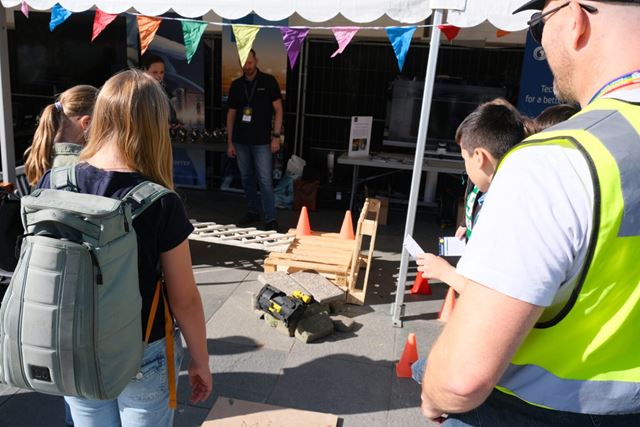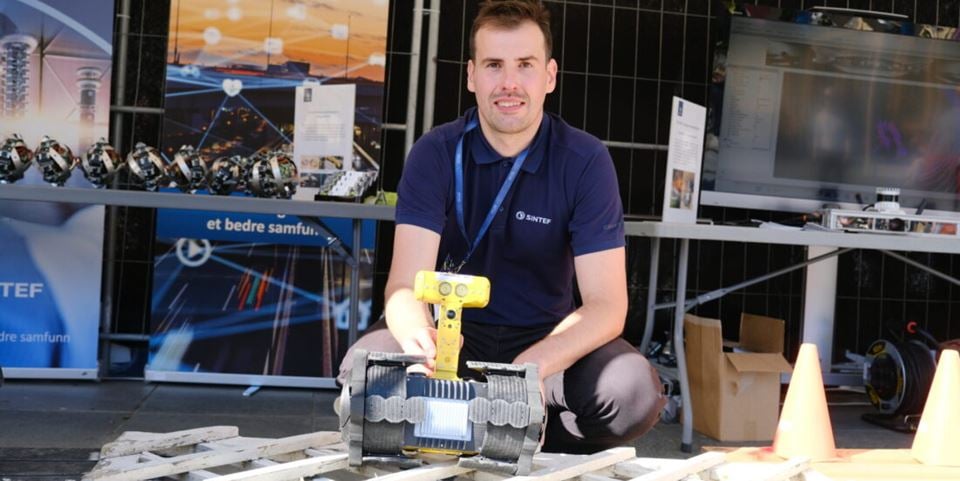“We couldn’t paint the robot blue like a traditional Smurf. It had to be painted with three reflective coats of yellow paint so that it’s clearly visible,” says Jan Sramota.
Sramota is a researcher at SINTEF and part of the team behind the rescue robot. The robot’s job is to move in after earthquakes, landslides, floods and other natural disasters. The rescue teams can unleash the yellow Smurfs when the situation becomes too unsafe for the human rescuers or there are too many places to handle at once.
Support for rescue dogs
“When an earthquake hits, you can’t search every single building immediately. You have to decide where the most survivors are likely to be and start there,” explains Sramota.
To find survivors, rescuers often use dogs.
“The problem is, first of all, that the environment is not very safe for dogs. There’s a lot of broken glass, sharp objects and maybe leaking gas. The second is that the dogs need to take breaks. A half-hour search is very tiring, so then a dog needs to rest,” he says.
Norwegian-Japanese collaboration
The Smurf is just one of many solutions being developed in a European research project called CURSOR, and SMURF is also often written in capital letters as an abbreviation for “Soft Miniaturised Underground Robotic Finders”.
“It’s a small robot that has been developed from scratch,” says Sramota. “SINTEF has collected the technology used for it, while researchers at Tohoku University in Japan built the actual robot.”

Curious schoolchildren are eager to say hello to the little “Smurf” designed to save lives. Photo: Emma Sæter
“When buildings collapse, communication disappears as well. You have to take everything you’ll need with you. One part of the project focuses on drones that fly up and hover over the area with cameras, lights that are bright enough to turn night into day, and two-way communication,” says Sramota.
Released from drones
Drones are also being used to release the Smurf robots to the designated scene. This enables the search for survivors to begin long before rescuers have determined that it is safe to enter the rubble. The wheels on the Smurfs are designed to withstand being dropped to the ground.
The Smurfs are equipped with lights, a regular camera, an infrared camera that sees heat, and a smell sensor that can detect the difference between people and animals and between the living and the dead. They also have built in two-way communication. This way, the emergency scene commander can talk to people who have been found, hear how they’re feeling and gain a better basis for determining who should be rescued first.
An affordable solution
One of the things that the researchers have learned during the project is that the robots need to be small and affordable. The current price tag will be around NOK 50 000 when they enter series production.
Facts about the project:
- CURSOR is an abbreviation for Coordinated Use of miniaturised Robotic equipment and advanced Sensors for search and rescue OpeRations.
- The EU-funded project develops new tools for faster and safer search and rescue operations.
- The project combines miniature robots, drones and advanced sensors to find survivors after disasters.
- The project involves researchers and businesses in seven European countries and Japan.
- Led by Technisches Hilfswerk (THW), which is the German civil defence.
- SINTEF is a Norwegian participant.
“In the past, we always tried to build a robot so well that it would never get stuck. That made them really expensive, and they always get stuck sooner or later. That’s why we focused on quantity and not making them so expensive that rescuers are afraid of losing them,” says Sramota.
He has heard of how people who are supposed to try to save lives after an accident or disaster have crawled into unsafe areas because they think someone might be there.
“They’ve risked their lives to get three metres further in and look down into a hole where there could be someone. Now we can send a rescue robot instead. You risk 50 000 kroner instead of a person’s life,” he says.
Tested in Trondheim
Sramota points out that the project has given individuals who are at the scene to save lives the opportunity to get involved with the project and test both the Smurfs and the other inventions in the CURSOR project.
“For example, we’ve tested the Smurfs with the Trøndelag Fire and Rescue Service when they conducted an exercise to find survivors in a building that had collapsed,” he says.
The robots have attracted so much attention that they were one of the very few research projects to be exhibited in the EU pavilion at the World Expo in Osaka this summer.
Sramota acknowledges that it is quite special to be invited there.


